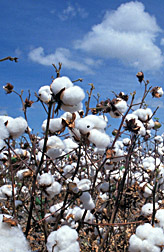This page has been archived and is being provided for reference purposes only. The page is no longer being updated, and therefore, links on the page may be invalid.
Read the magazine story to find out more. |
|
|
National Cotton Variety Test Program is 50 Years Strong
By Jan SuszkiwJanuary 19, 2010
Quite a bit of science has gone into American cotton over the years. Take, for example, the National Cotton Variety Test (NCVT).
Celebrating its 50th anniversary this month, the Agricultural Research Service (ARS)-led program was originally created in 1960 to standardize the collection and analysis of field data necessary for objectively evaluating new upland and pima cotton varieties.
To that end, the NCVT called for partitioning the U.S. Cotton Belt—which spreads south from Virginia to Georgia, and west to southern California—into six distinct growing regions. This arrangement has allowed researchers to systematically evaluate new, region-specific varieties and establish national standards in every test to serve as a link between regions, notes Bill Meredith, a geneticist who coordinates the program at the ARS Crop Genetics Research Unit in Stoneville, Miss.
To date, the NCVT program has tested more than 1,300 varieties, germplasms and strains. One of the greatest accomplishments coming out of the program's so-called "regional high-quality" test was the release of the variety DES 56. It's the "parent" or "grandparent" of almost all varieties grown in the Cotton Belt's Eastern, Delta and Central regions, according to Meredith.
Data amassed by the NCVT documents notable cotton production trends and helps determine the contributions of genetics, locations, years and crop-management methods to fiber yield and quality. For example, through plant breeding programs, cotton seed and boll size have decreased, while lint and yield have increased. And cotton grown today requires much less insecticide and herbicide than it did 50 years ago.
ARS' collaborators on the program include state experiment station personnel who conduct the tests, cotton growers, other industry members, trade groups such as the National Cotton Council of America, and agricultural companies.
Read more about this program in the January 2010 issue of Agricultural Research magazine.
ARS is the principal intramural scientific research agency of the U.S. Department of Agriculture.

